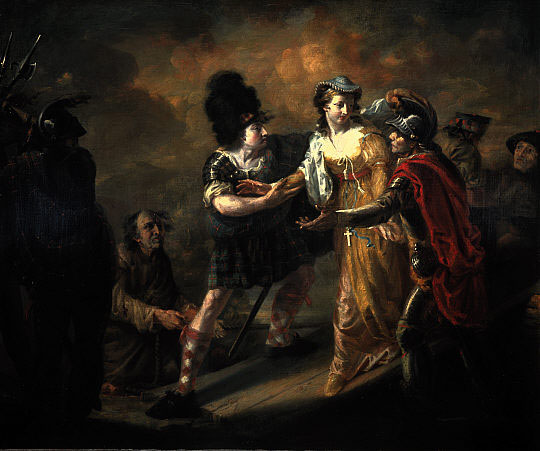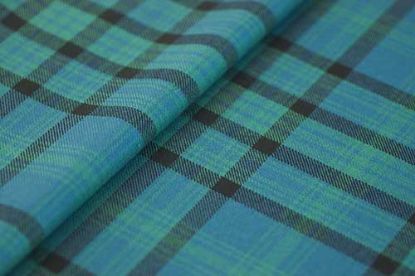24th July 1526 Battle of Melrose
The young James V was being held under the so-called protection of his step-father Archibald, 6th Earl of Angus and various members of the Scottish nobility, and Sir Walter Scott of Buccleuch was determined to free him. The King was being escorted from Jedburgh to Edinburgh when Buccleuch attacked the party at what was to become known as Skirmish Hill at Melrose. Buccleuch was injured in the fighting and, with heavy losses, obliged to retreat.
4th September 1526 Battle of Linlithgow Bridge
This was yet another attempt to release the 14-year old James VI from the custody of his step-father Archibald, 6th Earl of Angus. Having fallen out with Angus, who had become her second husband, the Queen Dowager Margaret, enlisted John Stewart, 3rd Earl of Lennox to her cause. Lennox raised an army to march on Edinburgh but was intercepted and his men dispersed at Linlithgow by James Hamilton, 1st Earl of Arran
24th August 1542 Battle of Haddon Rig
When Henry VIII of England broke with the Church of Rome, he wanted his nephew, James V of Scotland, to follow his example. But when James refused to meet him at York to discuss this, Henry sent an army north to assert his rights as Over Lord. When an English army led by Robert Bowes, Warden of the East Marches, invaded, they were met by the Scots under George Gordon, 4th Earl of Huntly, near Kelso and soundly defeated.
24th November 1542 Battle of Solway Moss
James V, anxious to assert his advantages after Haddon Rig, mustered a Scots army to retaliate on England, but was met by Sir Thomas Wharton and 3,000 men at Solway Moss. It was not so much a battle as a capitulation. James, who was ill from a fever at the time was at Lochmaben Castle, and withdrew to Falkland Palace in Fife. Within two weeks he had died at the age of thirty leaving only an infant daughter to become Queen of Scots.
15th July 1544 Battle of the Shirts (also known as the Battle of Kinloch-Lochy)
James V had imprisoned John of Moidart, 8th Captain of Clanranald and a dispute arose over who should take over the Clanranald Chiefship. A claim was made by Ranald Gallda, son of the 4th Captain of Clanranald. His mother was a Fraser, and when John of Moidart was released, Ranald took refuge with the Frasers of Lovat. Clan Donald supported by Clan Cameron then raided Fraser lands but were checked by George, 4th Earl of Huntly. The two sides met again at Kinlochbervie where Hugh Fraser, 4th Lord Lovat, the Master of Lovat, and Ranald Gallda were killed in battle. Tradition has it that in the intense heat of that summer day, the Highlanders discarded their armour and fought in their shirts.
27th February 1545 Battle of Ancrum Moor
Towards the end of his life, Henry VIII of England became increasingly determined that his son Prince Edward should marry the infant Mary Queen of Scots, and thus the two kingdoms embarked upon the period which became known as “The Rough Wooing.” Under the command of Edward Seymour, Earl of Hertford, a substantial English army was sent north in 1544 to force the Scots to comply, and succeeded in burning Edinburgh and much of southern Scotland. The following year, the combined forces of James Hamilton, 1st Earl of Arran and Archibald, 6th Earl of Angus took the English army led by Sir Brian Layton by surprise and scattered them, taking over 1,000 soldiers prisoner.
10th September 1547 Battle of Pinkie Cleugh (Black Saturday)
After Henry VIII's death, Edward Seymour, Earl of Hertford, was appointed Duke of Somerset and Protector of the Kingdom, and continued to press for a marriage between the ten-year old Edward VI and the five-year old Mary Queen of Scots. Somerset advanced his army into Inveresk, near Edinburgh, and was met by the Scots under the command the 1st Earl of Arran, the 6th Earl of Angus, and 4th Earl of Huntly. It is estimated that over 5,000 Scots were killed, and as a result the infant Queen Mary was rapidly smuggled out of the country and sent to France where she was betrothed to the Dauphin, son and heir to the French king Henry II.
18th April 1548 - 14th September 1549 Siege of Haddington
After the Scottish Parliament had convened at Haddington to endorse the sending of Mary Queen of Scots to France, the English seized and occupied the town. For the following eighteen months it was bombarded by Scots and mercenary canon while its occupants did their best to remain alive. Eventually the plague, which was sweeping southern Scotland at the time, persuaded the Duke of Somerset to evacuate his troops, leaving Haddington in ruins.
15th June 1567 Battle of Carberry Hill
When Mary Queen of Scots married James Hepburn, 4th Earl of Bothwell as her third husband, many of Scotland's Protestant lords who had previously supported her were incensed. By then, the majority were convinced that Bothwell was responsible for the murder of Mary's second husband, Lord Darnley. A month later, the Queen's supporters were challenged near Musselburgh, with Mary being taken prisoner and Bothwell escaping. Mary was imprisoned at Loch Leven Castle and the following month forced to abdicate.
 |
Mary, Queen of Scots Escaping from Loch Leven Castle, William Craig Shirreff (1786 - 1805). Oil on canvas 1805 |
13th May 1568 Battle of Langside
After escaping from her confinement at Loch Leven Castle in Fife, Mary Queen of Scots soon rallied her followers, but was opposed by her half-brother, James Stewart, the Regent Earl of Moray, who led an army to confront her in Renfrewshire. A cross section of the Scottish nobility still supported her, but as it transpired the ensuing battle only lasted forty five minutes with the Queen's supporters being dispersed. Mary and her contingent rode to Dundrennan Abbey in Galloway from which she departed to England, never to return.
3rd October 1594 Battle of Glenlivet
The catholic George Gordon, 6th Earl of Huntly, with a force of 2,000 supporters routed a force of 10,000 commanded by the protestant Earl of Argyll. The battle represented a victory of artillery and horse over irregular infantry.
7th February 1603 Battle of Glenfruin
According to tradition, two Macgregor clansmen had sought shelter in Colquhoun territory and slaughtered a sheep for food. When seized and brought before Sir Humphrey Colquhoun, the Colquhoun Chief, they were put to death. In retaliation, Alasdair MacGregor of Glenstrae, the Clan Gregor Chief, rallied four hundred men and marched on the Colquhoun stronghold at Luss. Although the Colquhouns largely outnumbered the Macgregors, they were decimated.
























